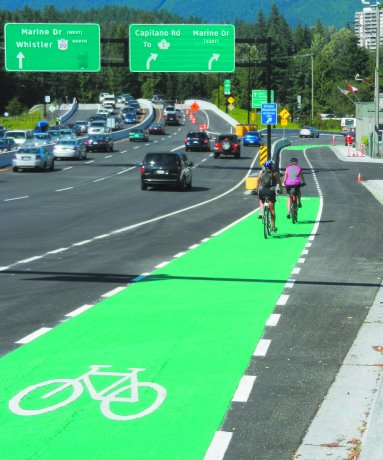Road markings are often applied by dark of night, leading drivers to take the efforts of road marking contractors for granted.
Lafrentz Road Marking explains, it’s an increasingly specialized discipline, dominated by technological change.
Zapf notes that three major developments are top-of-mind for road marking contractors.
Use of waterborne and low-VOC
(volatile organic compound) paints
"Just a few years ago road marking paints might contain as much as 55 per cent VOCs," says Zapf. "Now, environmental regulations have changed and contractors must use waterborne and low-VOC paints, which are a significant challenge to apply."
However, most low-VOC road paint manufacturers were located south of the border.
"U.S. manufacturers only spend so much money on R&D for Canadian applications," Zapf says. "Low-VOC paint that applies beautifully in Florida or Arizona doesn’t apply or dry so flawlessly on a cold night in Alberta, or a warm and humid day in Toronto. The paints take longer to apply and longer to set up, meaning that it also takes longer before traffic is allowed back on it."
These paints are also subject to quicker traffic wear, he notes. Whereas a typical crosswalk might be painted twice a year with the older paint, it may now be painted three times to maintain visibility.
Contractors and suppliers are offering more durable markings, such as cold plastic (methyl methacrylate) and thermoplastic materials, which use a heat process to create a hydrocarbon bond with oil in the road surface.
"We can put a line down that will last for 10 to 15 years, but often city councils find it difficult to justify a technology that may cost more than 10 times as much as paint," says Zapf. "While you see those lines used on highways including the 401 and 407, many municipalities are still in the paint business."
Retro-reflectivity
Retro-reflectivity describes the amount of light reflected back to the driver, through the use of glass beads imbedded in road surfaces.
"With an aging population, we’re seeing more emphasis on trying to determine how much retro-reflectivity is required to get sufficient information back to the older eye, especially at night and during heavy rains," says Zapf.
Glass bead manufacturers are now fine-tuning their designs to compensate for a film of moisture, ensuring that light is reflected from the beads even during heavy rains.
"Another way of achieving that effect is to ensure that the beads aren’t sitting on a flat surface, so water drains away," says Zapf. "We’re now doing applications where we’re creating an irregular line surface of four-millimetre peaks, which contain the beads. We’re simply milling off a fraction of an inch of road surface to the width of the line, and counter-sinking the line so that those peaks don’t prematurely wear away."
The Complete Street
The Complete Street concept is a roadway that carries all modes of transit from motor vehicles to bicycles to pedestrians. "Most municipalities are looking for ways to increase the number of bicycles and pedestrians using roads," says Zapf. "They’re following the mantra ‘if you build it, they will come.’"
Part of that effort includes road marking solutions that help avoid conflict between different users. These can range from coloured bicycle lanes offering a visual demonstration of where the lanes are located to marked transit lanes and skid-resistant pedestrian surfaces placed over the roadway.
"We’ve seen an increased interest in these products beginning in Western Canada," says Zapf. "The longest stretch we’ve contracted for is in Kelowna, with other applications located in potential traffic conflict zones on streets in Vancouver and Edmonton."
Zapf notes that the lifespan of thermoplastic products tends to exceed that of the road surface.
"Our oldest full-lane application in Canada is now seven years old," he says. "It’s usually the deterioration of underlying asphalt that creates the need to replace the markings."











Recent Comments
comments for this post are closed